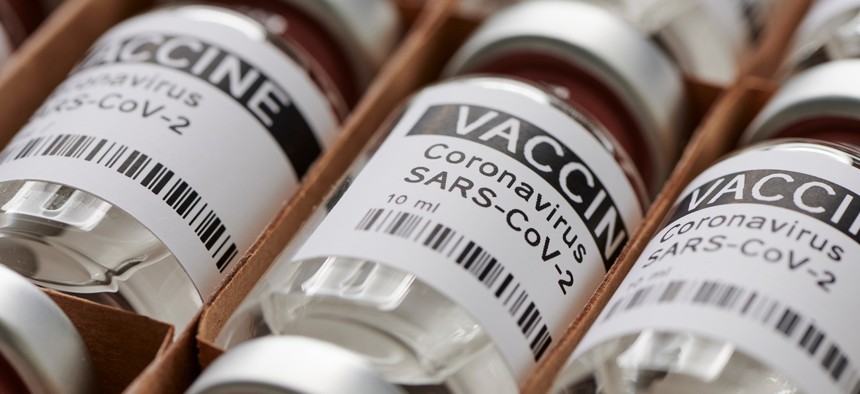
Shutterstock.com
Internal Documents Detail Who VA Will Vaccinate First
The Veterans Affairs Department's multi-tiered plan prioritizes delivering COVID-19 inoculations to high-risk staff and patients.
The federal agency that will likely receive the largest distribution of COVID-19 vaccine doses plans to quickly inoculate some employees upon first receiving the vaccine, according to internal documents describing the phased rollout, but other workers could wait for some time before they're eligible to receive the vaccine.
Like all jurisdictions around the country awaiting vaccines against the novel coronavirus, the Veterans Affairs Department is planning a multi-tiered, phased approach to inoculate its workforce and constituents based on the availability of doses. Staff will comprise four of the first five populations to receive the vaccine, according to a predecisional, draft document obtained by Government Executive. Employees at department nursing homes and its 25 Spinal Cord Injuries and Disorders Centers would receive the first batch of vaccines, followed by veterans at those facilities.
VA is one of five federal agencies slated to receive a direct distribution of vaccines from the Centers for Disease Control and Prevention after viable candidates are approved for use by the Food and Drug Administration. The department, which runs the largest health care network in the country, has faced criticism for failing to publicize a detailed vaccine distribution plan, with Democratic senators last week imploring VA to develop a comprehensive strategy. VA has told employees it will only finalize its vaccine strategy after a candidate is approved for use.
After vaccinating its employees and patients at long-term care sites—more than 105,000 veterans receive long-term care through VA—the department under the draft plan would move, in successive order, to inoculate staff in emergency departments, COVID-19 intensive care units and COVID-19 non-intensive care units. Employees in “other congregate living settings” and veterans over the age of 85 would then receive vaccines from VA. The department has not yet set out timelines for each phase of its distribution plan, as it would depend on vaccine availability.
Other employees considered critical to the function of VA’s COVID-19 response, including police and executives, would then be eligible for inoculations. Facilities would make determinations on “the smallest number of staff needed to continue operations” under the plan, rather than giving it to all workers with a certain job title. Inpatient staff in other units and staff performing high-risk procedures would receive the next batch of vaccines.
In a “frequently asked questions” document sent to employees, VA said it is focusing on the highest-risk individuals for the initial waves of distribution. It stressed, however, that it considered the risk of transmitting the virus to others above the personal risk of severe illness to the employees themselves. An employee delivering care to a veteran in a nursing home would, therefore, receive a vaccine before a nurse in a non-COVID unit with multiple high-risk comorbidities.
Potential Mistrust Issues
VA said it expects it will eventually be able to provide a vaccine to any employee who wants one. It will not, however, require employees to receive an inoculation, though it plans to “encourage” its staff to do so to protect themselves and the veterans they serve. In its presentation on its vaccine plan, VA pointed to studies showing significant segments of the population that are not committed to getting vaccinated. It highlighted younger individuals, Black individuals, those with lower educational attainment and those living in rural areas as the most hesitant.
The department did not spell out how it planned to address potential mistrust issues, but noted CDC guidance that said health care providers vouching for the vaccines could help mitigate those concerns. VA also identified logistical issues with the need to keep some of the candidate vaccine formulations at temperatures well below freezing—a potential roadblock to widespread distribution. The department spelled out its specific plans for storage, handling and administration of various scenarios based on the vaccines’ requirements.
In the final stages of VA’s plan, hemodialysis patients and staff would receive the vaccine, followed by chemotherapy patients and staff. All veterans older than 75 would then be eligible, followed by homeless veterans and homeless outreach workers. VA would then open its doors to veterans 65 and older for inoculation, followed by other employees who interact with patients. At this stage, VA would begin prioritizing patients with high-risk conditions or in high-risk minority groups. The department eventually would vaccinate veterans under 50 and all other staff, and ultimately expects to assist with individuals outside its network.
VA told employees they would still have to wear personal protective equipment even after receiving a vaccine. If multiple vaccines are available, employees will be able to choose which one they receive. The department has not yet determined if those who have already tested positive for COVID-19 would still be eligible for the vaccine.
The plan reviewed by Government Executive did not spell out the number of employees and patients VA expects to vaccinate in each phase, which was one of the key questions presented by the Democratic senators in their letter last week. About half of the 8 million veterans who receive care from VA are older than 65, meaning VA would require millions of doses before it opens up vaccines to all staff. Most front-line health care staff would have received a vaccination by that point, however. The senators also implored VA to work with veterans service organizations and other groups to address mistrust in vaccines.
The department assured employees it would eventually make a vaccine available to all of them.
“VA’s goal is to offer the COVID-19 vaccine to all employees and veterans who want it when supplies become available,” it said. “Eventually, we expect to receive enough supply to vaccinate all who choose to be vaccinated.”







